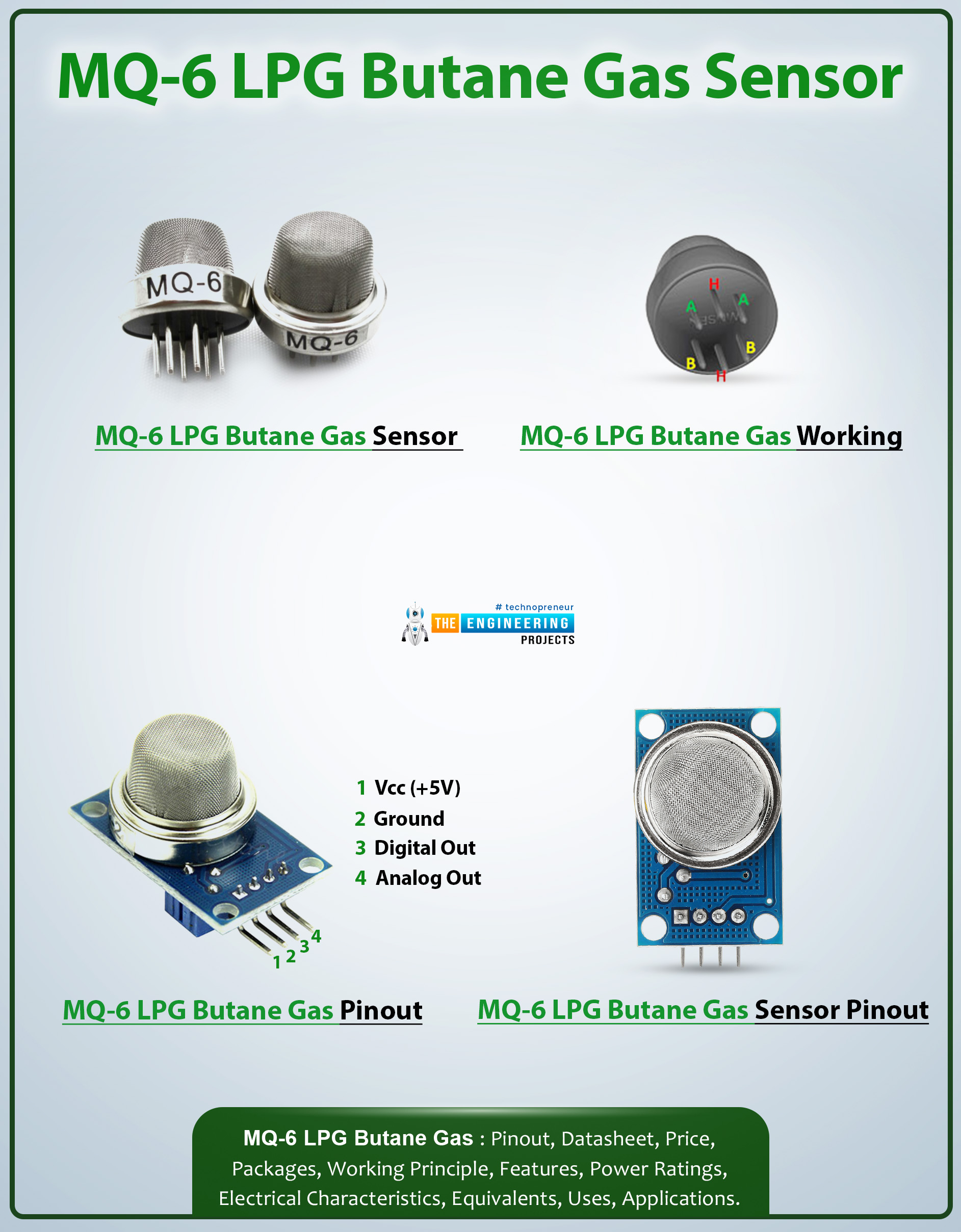
Hey pals! Welcome to the next article where we're studying a gas sensor from the MQ sensor series. Today, we’ll understand the MQ-6 LPG butane gas sensor and will know the basic information about this product. This sensor has sensitivity for gases like LPG, isobutane propane etc and it is widely used to check any leakage of these gases. These are the commonly used gases but any leakage or excessive use may be harmful and even life-threatening. In such cases, sensors like MQ-6 are proved one of the most important devices.
In this article, we’ll start the discussion with the introduction of the MQ-6 LPG butane gas sensor. After that, we’ll move towards the datasheet of this product in which we’ll study the specifications, features, and some graphs that will show its working. After that, we’ll work on the working principle and physical dimensions of this sensor and in the end, we’ll see some common examples of the applications in which this sensor is widely used.
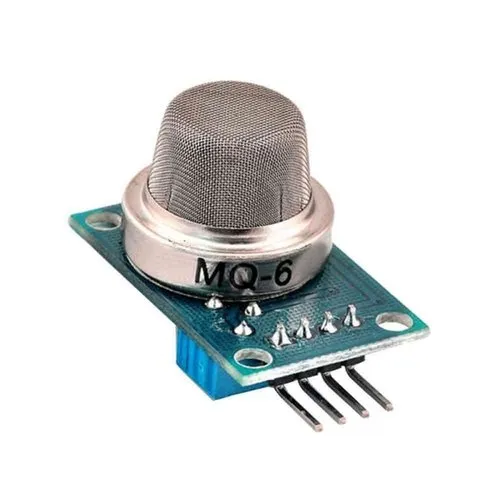
Let’s move towards the first topic:
MQ-6 LPG Butane Gas Sensor Introduction
Butane gas is not only used in houses but has a major role in multiple industries where it is used as a fuel. It is a common source of energy for factories but using safety precautions is the most important point to keep in mind and here, the duty of the sensor like MQ-6 starts. The MQ-6 LPG butane sensor detects the presence of leakage in the gases and provides the information in the form of analog values so that the user may know the amount of the gas present in the surroundings.
At the core of this gas sensor, there is a small and sensitive structure of different components that allow it to detect the LPG butane gas from the surroundings with the help of a change in the electrical conductivity. The basic components of this sensor are:
Micro AL2O3 ceramic tube
Sno2 (tin dioxide) layer
Measuring electrode
Heater
plastic and stainless steel net
Base
These components collectively prepare a small sensor compatible with different types of circuits. The following are the gases that can be detected using the MQ-6 LPG butane gas sensor:
Butane (C4H10)
Propane (C3H8)
Methane (CH4)
Alcohol vapors
Benzene
Carbon monoxide (CO)
Hydrogen (H2)
LPG (Liquefied Petroleum Gas)
The sensitivity of the MQ-6 sensor varies according to the type of the gas.
MQ-6 LPG Butane Gas Sensor Datasheet
Before using any electrical component, always check the datasheet for detailed information on the product. In the case of the MQ-6 LPG butane gas sensor, here are the important points that one must know:
MQ-6 LPG Butane Gas Sensor Features
As mentioned before, this sensor has a high sensitivity to LPG, iso-butane, propane and other similar gases.
It has a small sensitivity to gases like alcohol, and smoke but is not suitable to be used as only a sensor for these gases.
This sensor shows a fast response so is a reliable choice.
It works continuously therefore providing stable results and having a long life.
This sensor runs on the simple drive circuit
As soon as it is turned on, it takes only 20 seconds to preheat and starts working.
It can be used as a Digital or analogue sensor because it has both pins
The user can vary the Sensitivity of the digital pin using the potentiometer in its structure
MQ-6 LPG Butane Gas Sensor Specifications
The following table is the evidence of its different specifications regarding different types of parameters:
Category |
Parameter |
Technical Condition |
Remarks |
Standard Work Condition |
Circuit voltage (Vc) |
5V ± 0.1 V (AC or DC) |
N/A |
Heating voltage (Vh) |
5V ± 0.1 V (AC or DC) |
||
Load resistance (PL) |
20 KΩ |
||
Heater resistance (RH) |
33 Ω ± 5% |
||
Heating consumption (PH) |
Less than 750 mW |
||
Environment Condition |
Operating temperature (Tao) |
-10°C to 50°C |
|
Storage temperature (Tas) |
-20°C to 70°C |
||
Relative humidity (RH) |
Less than 95% |
||
Oxygen concentration (O2) |
21% (standard condition) |
Minimum value is over 2% |
|
Sensitivity Characteristic |
Sensing resistance (Rs) |
10 KΩ - 60 KΩ (1000 ppm LPG) |
N/A |
Concentration slope rate (α) |
≤ 0.6 (1000 ppm / 4000 ppm LPG) |
Standard detecting condition: Temp: 20°C ± 2°C, Vc: 5V ± 0.1 V, Humidity: 65% ± 5%, Vh: 5V ± 0.1 V, Preheat time over 24 hours |
|
Detecting concentration scope |
200-10000 ppm |
LPG, iso-butane, propane, LNG |
MQ-6 LPG Butane Gas Sensor Basic Structure
The basic compoeents of the MQ-6 LPG butane sensor have been discussed before but now, let’s have a look at the internal structure of this sensor to understand its working. Here is the circuit diagram for this purpose:
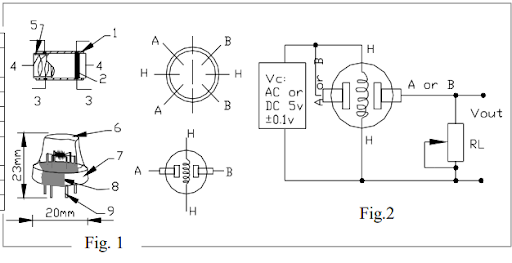
The detail of each label and its description is written here in the table below:
Component |
Material |
Description |
1 |
SnO2 |
Gas sensing layer - responsible for detecting target gases through changes in resistance. |
2 |
Au |
Electrodes - facilitate electrical contact with the gas sensing layer. |
3 |
Pt |
Electrode line - connects the electrodes to the external circuitry. |
4 |
Ni-Cr alloy |
Heater coil - provides heat to activate the gas sensing layer and increase sensitivity. |
5 |
Al2O3 |
Tubular ceramic - housing and support for the gas sensor components. |
6 |
Stainless steel gauze (SUS316 100-mesh) |
Anti-explosion network - prevents flame propagation into the sensor body. |
7 |
Copper plating Ni |
Clamp ring - secures the sensor components within the tubular ceramic. |
8 |
Bakelite |
Resin base - provides mechanical support and electrical insulation for the sensor. |
9 |
Copper plating Ni |
Tube pin - electrical connection point for the sensor. |
MQ-6 LPG Butane Gas Sensor Sensitivity Characteristics
The MQ-6 LPG butane gas can detect multiple gases but the sensitivity varies according to the type of the gas. With the help of continuous experimentation, the sensitivity of this detector can be examined using the graph given below:
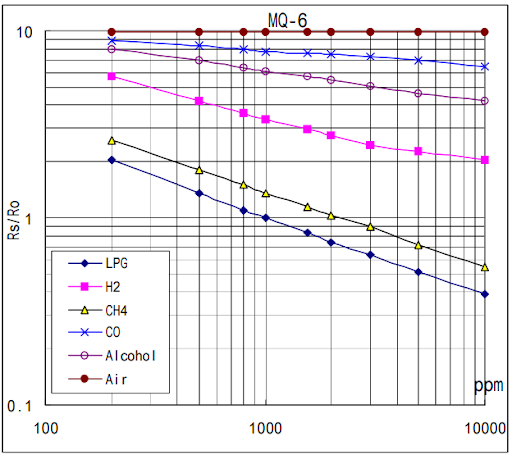
Here, other parameters such as temperature and humidity are kept constant. The above image shows the sensitivity of the MQ-6 LPG butane gas sensor in the range of 100-1000 ppm. Here,
Rs:
It stands for sensing resistance.
It represents the actual resistance of the sensor in the presence of a specific gas concentration.
It changes based on the gas concentration which decreases as the concentration increases.
Ro:
It stands for Reference Resistance.
It represents the sensor's resistance in clean air (absence of target gases).
It is usually measured when the sensor is powered on and heated to operating temperature in a gas-free environment.
Rs/Ro:
It represents the ratio of sensing resistance (Rs) to reference resistance (Ro).
This ratio provides a normalized value to compare the sensor's response across different gas concentrations and environmental conditions.
The higher Rs/Ro values generally indicate the presence of higher gas concentrations.
If you want to have more detail about its datasheet you can visit the link below and get all the information:
MQ-6 LPG Butane Gas Sensor Pinout Configuration
The four-pin MQ-6 butane gas sensor is easy to install and has the simple pin configuration that is mentioned in the table below:
Pin Name |
Description |
Vcc |
This is the power Pin that requires an operating voltage of 5V. |
GND |
Ground pin connected to the ground terminal of the circuit |
DO |
It is a digital output pin that needs to set the threshold value using a Pot. |
AO |
Analog out the pin. It based the output of this pin on the intensity of the LPG or other gas. |
MQ-6 LPG Butane Gas Sensor Packages
For the convenience of the users, the MQ-6 LPG butane gas sensor is present in different types of packages. Here is a brief introduction of these:
Package Type |
Description |
Size |
DIP (Dual In-Line Package) |
Standard through-hole package with pins for soldering to a PCB |
Varies between manufacturers (e.g., 20x20x30mm) |
SMD (Surface Mount Device) |
Smaller package designed for surface mounting on PCBs |
Varies between manufacturers (e.g., 10x10x5mm) |
Module Package |
Pre-assembled module with additional components like voltage regulators and filtering capacitors |
Varies between manufacturers |
MQ-6 LPG Butane Gas Sensor Alternatives
The butane is a widely used gas, therefore, there are different alternatives present in the market that have the same good performance as the MQ-6 LPG butane. Some of these belong to the MQ family and others are from different classes. Here are some alternatives:
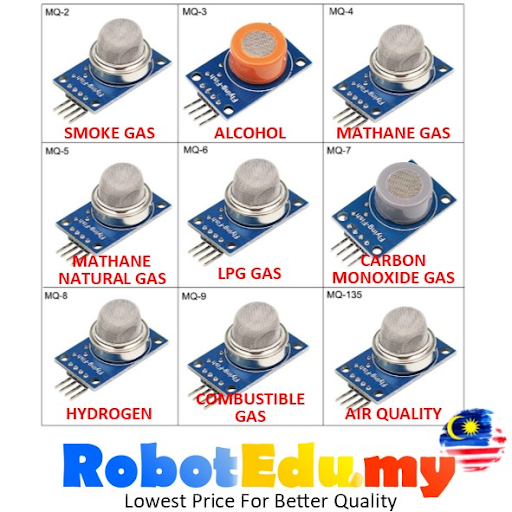
Metal Oxide Semiconductor (MOS) Sensors
MQ-2
MQ-3
MQ-4
MQ-5
MQ-7
MQ-8
MQ-9
MQ135
Electrochemical Sensors
MiCS-5525/5526
SGX Sensortech MiniMOS
CityTech SEN5X
Infrared (IR) Sensors
Senseair NDIR sensors
SGX Sensortech IR sensors
Where to Buy MQ-6 LPG Butane Gas Sensor?
The electrical components are delicate and the performance varies because of different parameters. Here are some platforms where you can have the best quality MQ-6 LPG butane gas sensors:
eBay
AliExpress
Amazon
MQ-6 LPG Butane Gas Sensor Working Principle
The working of the MQ-6 LPG butane gas sensor is similar to the other MQ sensors. I have divided the working principle into different steps and will understand the basic flow:
MQ-6 LPG Butane Gas Sensor Heating Process
When the sensor is turned on, the circuit starts heating the core of this sensor that has the sensitive element SnO2 layer. This process is done to maintain a temperature of around 300°C (572°F) which activates the sensing element and it starts absorbing the oxygen from the surrounding air.
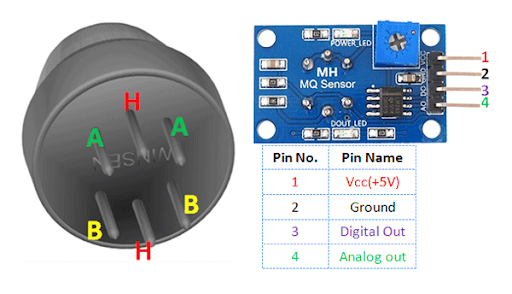
MQ-6 LPG Butane Gas Sensor Ion Creation
The result of the reaction in the previous step creates the depletion region around the sensing element. As a result, the electrical conductivity of the circuit decreases because of the high resistance.
MQ-6 LPG Butane Gas Sensor Gas Absorption
Once the MQ-6 LPG sensor comes into contact with the target gas, the oxygen ions from the depletion region start reacting with the gas molecules and as a result, the depletion region starts adsorbing. This causes the reduction in the number of oxygen ions and the overall conductivity increase.
MQ-6 LPG Butane Gas Sensor Resistance Measurement
The circuit of the sensor measures the change in the resistance and the electrical current as well. The change in the current is directly proportional to the amount of the target gas in the environment. In this way, the analog values are sent to the output device through the analog output pin.
MQ-6 LPG Butane Gas Sensor Digital Output
The MQ-6 provides the feature of digital output as well. The analog values, when exceeding the threshold value set through the potentiometer, are converted into the digital output and the sensor sends the signal through the digital pin. This is useful because usually, this pin is connected to the alarm and in the systems like an automatic alarm that shows the signal of the LPT butane gas presence.
MQ-6 LPG Butane Gas Sensor Physical Dimensions
Dimension |
Value |
Units |
Length |
32 |
millimeters (mm) |
Width |
20 |
millimeters (mm) |
Height |
22 |
millimeters (mm) |
Weight |
7 |
grams (g) |
Package Type |
DIP (Dual In-Line) |
- |
Pin Count |
6 |
- |
Pin Spacing |
2.54 |
millimeters (mm) |
MQ-6 LPG Butane Gas Sensor Applications
Here is a list of simple and basic examples that show the applications where the MQ-6 LPG butane gas sensor is extensively used:
Gas Leak Detection
- Homes
- Industries
- Vehicles
Air Quality Monitoring
- Indoor environments
- Industrial settings
Combustible Gas Safety Systems
- Appliances
- Furnaces
- Leak detection alarms
Environmental Monitoring
- Landfill gas detection
- VOC monitoring
Portable Gas Detection Devices
- Personal safety monitoring
- Industrial inspections
Research and Development
- Flammable gas sensing experiments
- Sensor evaluation and comparison
So, we have studied the MQ-6 LPG butane sensor in detail. We have started our discussion with the basic introduction of this sensor. We’ve seen the gases it can detect, the details of the datasheet, its pinout configuration, working graphs, its internal features, and the working principle in detail. After that, we saw the alternatives and package details along with the physical dimension of this sensor. In the end, we saw examples of different domains where this sensor is widely used. I hope I have covered all the points and you like the content.



